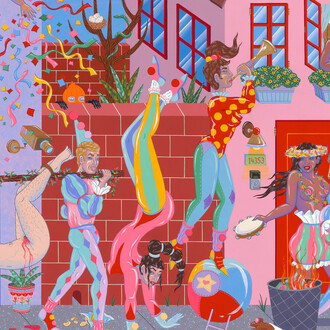Abstraction in perspective is a show about how abstract forms and concepts can come into perspective as we experience art. It is about ways to walk through the space between the shapeless and that which is no longer mere thought. Rocío García, Eduardo Hoffmann, Martina Kalevich, Fletcher Smith, and Gagik Vardanyan belong to those artists that walk this fine line. In their work we can see a heterogeneous use of abstraction and, in some cases, elements of perspective, to enable us to reach memories, sensations, and feelings.
Rocío García turns abstraction into a reference to her roots. An image of a vast black form that looks like a mountain with a void space turns into a map of Latin America as we move further away. As we move closer, we can see the small details of a superb use of small colored textures that provide depth and movement. At the same time, these almost collaged shapes remind us of the great Uruguayan artist Joaquín Torres García, in yet another layer of Latin reference.
In the case of Eduardo Hoffmann, paints and techniques are mixed to build images of profound color, sometimes warmer and other times colder, but always with the strength to transport us to other places. His chromatic exploration leads us to unexpected spaces of thought, to the boundless cosmos of our imagination. The canvas turns into a source of light as the color and brightness expand and fill the room.
Martina Kalevich’s pieces show us labyrinths of thorns where colors turn to life and talk about her story, her home. The shapes are precise and yet difficult to define, they escape us. They twist and turn, and twist again. Kalevich’s forms are geometric and random; they draw us in and, at the same time, keep us at a distance.
The works of Fletcher Smith, on the other hand, reveal their secrets when we stand at a certain angle. Their parallel lines become images, jokes that reference pop culture. That way we discover how art can turn humorous and yet remain captivating. The use of black and white tones, the difference in the spacing, and the distinctive print technique result in images that we can only see as we move.
Finally, Gagik Vardanyan employs repetition as a tool for expression. We can see small rectangles of color shaped like bacteria under a microscope, “infecting” the canvas with life. The geometric shapes (lines and circles, for example) merge into a system that we can’t quite define. It radiates hope.
All these artists dig up deep within our thoughts and feelings through abstraction and color. They all show us their perspective on life and art, and they make us think and experience contradiction and coincidence, separation and union. In sum, they share their lives with us, and allow us to share ours with their work.
(Jonathan Feldman, PhD)
In a world where every individual perceives reality through their unique lens, the concept of perspective becomes a powerful tool for artistic exploration. At Pablo Bogdan’s Gallery in LA, the art show titled "Abstraction in Perspective" delves into the interplay between perspective, abstraction, and the viewer's interpretation. This captivating exhibition challenges traditional artistic norms, inviting observers to actively engage with the artwork, infusing their own experiences and emotions to give meaning to each piece.
The heart of "Abstraction in Perceptive" lies in its emphasis on visitor engagement. Throughout the exhibit, visitors are encouraged to reflect on their own interpretations, emotions, and memories that the artworks evoke.
USA artist Fletcher Smith’s pieces are revealed by the viewer only at one exact angle, but otherwise distorted or nonexistent. Smith’s exhibit features paintings that head-on, look like misshapen lines, but from an angle form an image so precise it looks like a photograph.
“Abstraction in Perspective” also includes artists Martina Kalevich from Kazakhstan, Eduardo Hoffmann from Argentina, Rocio Garcia from Mexico and Gagik Vardanyan from Armenia. All pieces will celebrate the infinite ways in which observers connect with art, then the exhibition becomes a celebration of the diversity of human experiences. As visitors navigate through this captivating space, they not only witness artistic expressions but also find themselves as integral contributors to the ongoing narrative of each piece.
When Leonardo Da Vinci created the idea of “perspective”, the dominating aesthetic was an art that represented the world figuratively as through an open window. In his conception, perspective was a tool to perfect representation and the embellishment of the figure was only a natural way to achieve artistic value. Beginning with the vanguards, the search for abstraction came as a reaction to figurative representation, and it slowly but firmly turned into a powerful way of expression.














